Z-class Melbourne tram
The Z-class are single-unit bogie trams that operate on the Melbourne tram network. Between 1975 and 1983, 230 trams spanning three sub-classes were built by Comeng, Dandenong. The design was based on two similar Gothenburg tram models, and a prototype built by the Melbourne & Metropolitan Tramways Board. While the Z1 and Z2-class trams were very similar, the Z3-class had significant design changes.
| Z-class | |
|---|---|
_in_Swanston_St%252C_December_2013.JPG.webp) Z3 139 on Swanston Street in December 2013 | |
| Manufacturer | Comeng |
| Assembly | Dandenong |
| Constructed | 1975–1983 |
| Entered service | 1975- |
| Number built | 230 |
| Number in service | 111 (July 2019) |
| Fleet numbers | Z1 1-Z1 100 Z2 101-Z2 115 Z3 116-Z3 230 |
| Capacity | Z1/Z2: 48 Z3: 42 (Seated) 70 (Standing) |
| Depot(s) | Brunswick Essendon Glenhuntly Malvern |
| Specifications | |
| Train length | Z1/Z2: 16.00 m (52 ft 6 in) Z3: 16.64 m (54 ft 7 in) |
| Width | 2.67 m (8 ft 9 in) |
| Height | Z1/Z2: 3.55 m (11 ft 8 in) Z3: 3.41 m (11 ft 2 in) |
| Doors | Z1/Z2: 4 Z3: 6 |
| Weight | Z1/Z2: 19 t (19 long tons; 21 short tons) Z3: 21.8 t (21.5 long tons; 24.0 short tons) |
| Traction motors | Z1/Z2: 4 x ASEA LJB 23/2 57 kW Z3: 2 x AEG ABS 3322 195 kW |
| Electric system(s) | 600 V DC catenary |
| Current collection method | Pantograph |
| Bogies | Z1/Z2: ASEA/GS type 28 Z3: Duewag |
| Track gauge | 1,435 mm (4 ft 8 1⁄2 in) standard gauge |
Since introduction they have had a variety of liveries, and modifications. The Z1 and Z2-class trams have been retired, with 111 Z3-class trams remaining in service.
History

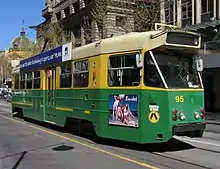
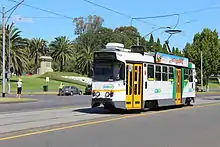
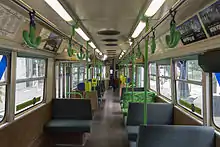

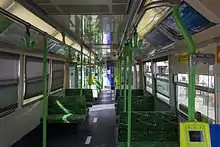
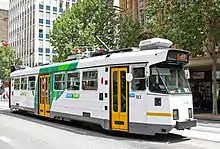
When Melbourne & Metropolitan Tramways Board (MMTB) staff were sent to Europe in 1965 to investigate other tramway operations, they took interest in Swedish trams, and upon return in 1966 drew up specifications, and had a timber mockup built. This mockup was to be the basis for a new tram design for Melbourne. The MMTB approved of the design, and in 1972 requested a prototype be constructed, the result was PCC 1041 being built at Preston Workshops. It was 'European in appearance' and utilised some components bought new, and many recycled from an earlier prototype tram, PCC 980.[1]:195–196 Prototype PCC 1041 became the basis of the Z-class trams, with 230 trams influenced by the Gothenburg, Sweden M28 design, built by Comeng, Dandenong between 1974 and 1983.[1]:197[2][3]:32
Between 1995 and 1999, the remaining 106 Z1s and Z2s were refurbished by Goninan.[4] The bodies were overhauled in an area of Preston Workshops allocated to Goninan while the bogies were sent to Goninan's Auburn, New South Wales facility. On all bar four, the flap type destination displays and route number indicators were replaced by dot-matrix displays.[5][6][7]
When the Melbourne tram network was privatised in August 1998, M>Tram were allocated 94 Z1s, 12 Z2s and 84 Z3s while Yarra Trams received 31 Z3s. Yarra Trams later transferred its Z3s to M>Tram in 2002 as the C class trams arrived to replace them. Yarra Trams’ former units were either refurbished and repainted in M>Tram livery or left in the former Met Green & Yellow livery after their transfer to M>Tram[8]
It was envisaged that the delivery of the C and D class trams would allow for the Z1 and Z2s to be retired after the 2006 Commonwealth Games, however rising patronage levels would require the retention of 30 Z1 and three Z2s until the E class trams entered service from 2014. Half of these remained in service in December 2015.[7] The last were withdrawn in April 2016.[5]
In late 2007, the Z3s with analogue signage were refitted with digital signage, replacing the original rolling route destination displays.[7][9]
Liveries
The Z1 and Z2s were delivered in a livery of marigold (orange) with oriental gold roof; the first four or so were numbered with W2 gold-and-black transfers, but were later changed to the same off-white-and-black as carried by rest of the Z-type in Marigold or Deep Yellow livery. The Z3s were delivered in a livery of deep yellow (pale orange) with a burmese gold roof. For both liveries, the window-level panels were painted off-white (officially "string"), and skirt panels below floor-level were chocolate brown to match the bogies and wheels. From Z3 223 onwards, all were delivered in the Metropolitan Transit Authority's olympic green and wattle yellow livery.[10]
Subclasses
The initial 80 were classified as the 'Z class. After modifications were made to the suspension, the next 20 entered service as the Z1 class. As the first 80 received these modifications, they were reclassified as Z1s.[11] The next two batches were delivered as the Z2 and Z3s'.[5]
Z1-class
In 1972 Rupert Hamer became Premier of Victoria, promising new trams, which had been highlighted as needed in the 1969 Melbourne Transportation Plan. Comeng, in anticipation of a tender, dispatched workers to Europe who, knowing of the fondness within the MMTB of the Swedish tram design, acquired the plans for the Gothenburg M29 tram from Hägglund & Söner. It was understood that ASEA would supply the electrical equipment, as they had been involved in the supply of equipment for the Gothenburg M28 which was almost identical to the Gothenburg M29 trams, and had recently acquired the rolling stock division of Hägglund & Söner.[1]:196–197
Tenders for 100 trams based on prototype PCC 1041's design were called for in 1972 with Comeng awarded a contract in 1973.[12] The plans purchased by Comeng proved to be less useful than anticipated, due to them being metric, single ended (with doors only on one side), and to some extent 'over-designed'. Comeng essentially started anew, but retained elements of the structural design and ASEA as the electrical equipment supplier, who would supply equipment from the Gothenburg M28 design.[1]:197–198[13][14]
There were a number of design changes made which differentiated the Z-class from PCC 1041, including the destination display arrangement.[1]:198 Internally they, like PCC 1041, had conductors consoles that passengers would have to queue for, and only two doors per side, these two features hampered loading and proved unpopular.[1]:196[2] Fitting the ASEA M28 equipment into the Z-class body, which was heavily based on the M29, posed a problem due to the extra doors, tapered ends, and second cab Comeng had added to make them able to operate in Melbourne, this necessitated lengthening the design to accommodate the equipment.[1]:199
Construction started at Comeng Dandenong in 1974, with Dandenong's workforce tripling to cope with the order.[1]:199–200 The first Z1-class tram was delivered in December 1974, and the last in May 1978.[1]:203 Major construction was carried out at Dandenong, with bogie frames fabricated at Granville, and final fit out and commissioning occurring at the MMTB's Preston Workshops.[1]:199–200, 202
After being unveiled to the press on 30 April 1975, the first entered service on route 64 on 5 May 1975 and the second on route 72 two days later.[15] As more were delivered, the first 15 were concentrated at North Fitzroy depot to operate route 96 from 30 June 1975.[16][17]
Soon after commissioning it became apparent that the Z-class had ride problems due to stiff suspension, and track differences between Gothenburg and Melbourne. The issues were rectified by the time the 80th tram was constructed, and the fix, rubber secondary suspension, was retrofitted to all trams. The braking systems also had issues, and were seen as insufficient by the MMTB.[1]:203[18]:31
In anticipation of the Z3-class contract, Z1 No. 5 was fitted with chopper control in November 1977 for evaluation purposes and reclassified ZC-class No. 5.[5][19] Although it was converted back later, the test successfully demonstrated chopper control trams could operate on the Melbourne tram system without causing interference, and all Z3-class trams were fitted with chopper controls.[18]:31
In March 2006, Z1-class' 81 was returned to service as the Karachi to Melbourne Tram for the 2006 Commonwealth Games. Renumbered W-11 in recognition of buses operated in Karachi, Pakistan famous for their entertainment value, it was decorated with lush designs and played Bhangra and Pakistani music. For the duration of the games it operated on the City Circle.[20] It returned to service in the summer of 2006/07 operating Friday night City Circle services.[21]
Most of Z1-class were withdrawn following the introduction of the C and D class trams in 2001/02. Most were sold at auction, with some being donated to tram museums. In December 2013, 30 were still in service, by December 2015, 15 remained with the last withdrawn on 24 April 2016.[5][22] Four have been preserved.[23] Their internal refurbishment had less refurbished features than Z3-class, only seat pads and grab rails/anchors were replaced.[24]
Z2-class
Between June 1978 and February 1979, 15 more trams were built as Z2-class, as an extension of the Z1-class' order. These varied very little from the Z1-class, the main visual differences being the deeper bumper (6-channel like the Z3-class; Z1-class having 4-channel bumpers), and the slide-opening portion of the drivers side-window also being deeper (although at least one Z2 later had a Z1-type drivers side-window fitted).[1]:203[2] In December 2013, 3 were still in service. But by December 2015, only one remained in service.[25] It was withdrawn in April 2016.[5][24]
Z3-class
A tender for 100 new trams was called by the MMTB in early 1977, Ansair, Comeng and Siemens tendered. Although Comeng originally planning on using ASEA control equipment, as in the Z1 and Z2-class, they opted to give the MMTB a variety of options, leading to 28 different possible configurations of control equipment, bogies, and suspension types. Comeng were ultimately selected, and between 1979 and 1983, 115 Z3-class trams were built.[18]:31–36
Although superficially similar to the preceding Z1 and Z2-class trams' externally, they had significant design differences - and were a significant improvement on the Z1 and Z2-class trams.[18]:31–36[26] They are fitted with AEG control equipment and Duewag bogies, have an additional door each side (for a total of three rather than two for the Z1 and Z2), drop down (as opposed to top sliding) Beclawat windows and improved headlights. The unreliable flap type destination displays and route number indicators were replaced by rolling plastic film destination displays. They also had much smoother acceleration and braking performance, and improved suspension. Even though the rear door is only half-width (2-leaf, as opposed to the others being 4-leaf), this in combination with the centre doors being directly opposite contributed to better passenger-flow. The Z3-class build process went smoothly, with few problems, bar a slow delivery of equipment from AEG, and a few minor faults that required remedying after construction.[2][3]:32[18]:31–36[27] One (Z3 149) was scrapped after being destroyed in a fire in 1999.[28]
On 31 July 2000, Z3 214 was used to convey the Olympic flame along Dandenong Road from the intersection with Hawthorn Road to Chapel Street as part of the 2000 Summer Olympics torch relay.[29] On 26 October 2011, 'Z3 158, specially liveried as a Royal Tram was used to convey Queen Elizabeth II and Prince Philip along St Kilda Road from Federation Square to Government House during their visit to Melbourne. The Royal Tram remained in regular service until February 2013.[30][31][32][33]
In 2013, a program commenced to refurbish all remaining 114 Z3-class trams at Preston Workshops. They received new seats, painted interior walls, glass replacement with scratch proof film applied, and the Public Transport Victoria livery at Preston Workshops.[34][35] As at July 2019, 111 remain in service.[36]
Use
The Z3-class operate on the following routes:
- 1: East Coburg to South Melbourne Beach
- 3/3a: Malvern East to Melbourne University
- 5: Malvern to Melbourne University
- 6: Glen Iris to Moreland
- 16: Kew to Melbourne University
- 57: West Maribyrnong to Elizabeth Street
- 58: West Coburg to Toorak
- 64: Brighton East to Melbourne University
- 67: Carnegie to Melbourne University
- 72: Camberwell to Melbourne University
- 82: Footscray station to Moonee Ponds Junction
Preservation
Several have been preserved:
- Z1 5 by the Tramway Museum Society of Victoria
- Z1 11 by the Bendigo Tramway Trust[37]
- Z1 74 by the Bendigo Tramway Trust[37]
- Z1 80 by the Darling Downs Historical Rail Society, Toowoomba[38]
- Z1 81 by VicTrack, on display at Hawthorn depot as the Karachi to Melbourne Tram[39]
- Z2 111 by the Sydney Tramway Museum[40]
References
- Dunn, John (2010). Comeng: A History of Commonwealth Engineering Volume 3: 1966 - 1977. Kenthurst: Rosenberg Publishing. ISBN 9781877058905.
- Hoadley, David. "Melbourne's Z-class tram". Trams of Australia. Retrieved 6 November 2011.
- Wilson, Randall; Budd, Dale (2005). Melbourne tram book. Sydney: University of New South Wales Press. ISBN 0 86840 646 5.
- "Melburne to invest more" Railway Gazette International July 1996 page 411
- "The Melbourne Z1 and Z2 Class Tramcars" Railway Digest July 2016 pages 28-31
- "Z Series Cars - Overhauls & Modifications" Trolley Wire issue 273 May 1998 page 16
- Wilson, Randall; Budd, Dale (2015). Destination Waterfront City - A Guide to Melbourne's Trams. Sydney: Transit Australia Publishing. pp. 29–32. ISBN 9780909459277.
- "Melbourne News" Trolley Wire issue 279 November 1999 page 25
- "Business as usual at Yarra Trams". Yarra Trams. 21 August 2007. Retrieved 29 September 2013.
- Cross, Norman; Budd, Dale; Wilson, Randall (1993). Destination City Melbourne's Electric Trams (5 ed.). Sydney: Transit Publishing Australia. pp. 9–16. ISBN 0 909459 18 5.
- "City Section" Trolley Wire issue 182 June 1979 page 20
- "Melbourne gets tram bid go-ahead" Railway Gazette International April 1973 page 164
- "ASEA and Comeng gain Melbourne tram order" Railway Gazette International August 1973 page 285
- "ASEA equips Comeng tramcars for Melbourne" Railway Gazette International August 1974 page 319
- "Melbourne's new trams" Trolley Wire issue 158 June 1975 page 35
- "New Cars for North Fitzroy" Trolley Wire issue 159 August 1975 page 40
- "City Section" Trolley Wire issue 162 February 1976 page 22
- Dunn, John (2013). Comeng : A History of Commonwealth Engineering, Volume 4 : 1977-1985. Kenthurst: Rosenberg Publishing. ISBN 9781922013514.
- "City Section" Trolley Wire issue 172 October 1977 page 27
- Last rides on the Karachi tram Melbourne 2006 25 March 2006
- The Karachi Tram - back on the streets of Melbourne every Friday night during daylight savings Yarra Trams 23 November 2006
- Z1 Class Vicsig
- Vines, Gary (2012). "Melbourne Metropolitan Tramway Heritage Study - Tram rolling stock - Part 2" (PDF). Biosis Research. Department of Transport, Planning and Local Infrastructure. Retrieved 26 November 2013.
- Zed's nearly dead: Melbourne's first modern trams to be retired within days The Age 13 April 2016
- Z2 Class Vicsig
- "Melbourne and Metropolitan Tramways Board - Z3 class tram" (PDF). Council of Tramway Museums of Australasia. Retrieved 24 November 2013.
- "Melbourne's Z3 trams enter service" Railway Gazette International April 1980 pages 286/287
- Z3 149 Vicsig
- "Trams and the Olympic Torch Relay" Trolley Wire issue 283 November 2000 page 10
- "Royal Tram now in public service" (Press release). Yarra Trams. 26 October 2011. Retrieved 8 November 2011.
- Shmith, Michael (27 October 2011). "Not the Rolls or Bentley, but a commoner's conveyance gives Her Majesty a royal ride". The Age. Retrieved 8 November 2011.
- Zeeman, Rebecca (25 October 2011). "Z-class a tram fit for a Queen". The Age. Retrieved 9 September 2013.
- "A royal tram journey" Trolley Wire issue 327 November 2011 page 16
- "Makeover for Z-Class trams". Yarra Trams. 22 August 2013. Retrieved 9 September 2013.
- Z-Class Yarra Trams
- Ze Class Vicsig
- "Two new arrivals" Trolley Wire issue 292 February 2003 pages 46-58
- "A Z goes narrow gauge" Trolley Wire issue 306 August 2006 page 20
- Yarra Trams Z1 Class No81 Karachi W11 Melbourne Tram Museum
- "Z2 class tram 111" Trolley Wire issue 293 May 2004 pages 38/39
External links
![]() Media related to Z class trams at Wikimedia Commons
Media related to Z class trams at Wikimedia Commons